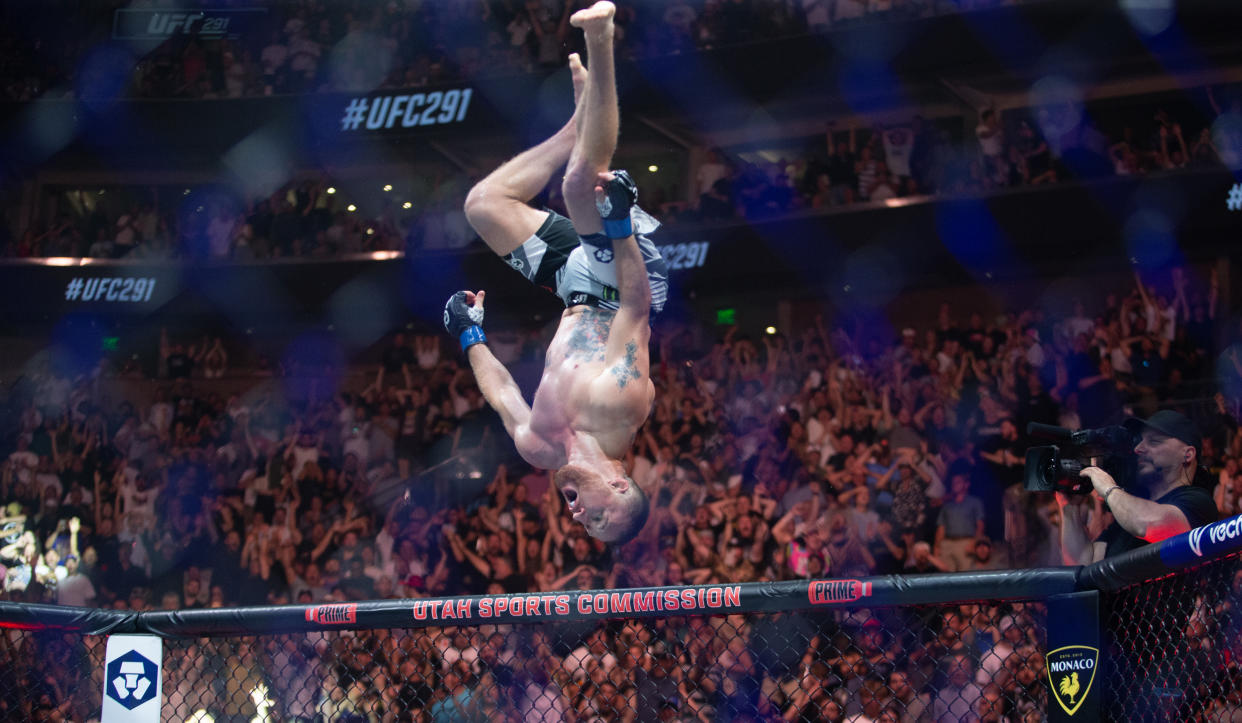How UFC 300 makes its case on overall value over individual star power
Any MMA fan knows that there are times when you will have to explain things about this sport to your non-fight fan friends, and at those times you might sound a little kooky — even to yourself.
This is inevitable. Maybe it happens when someone asks, "Wait, is it true that a dude bit another dude in a UFC fight recently?" Or perhaps when they ask, "Hold on, so you can’t bite but you can basically win by poking the other guy in the eyes repeatedly?" Somewhere in here you may be called upon to weigh in on whether Jake Paul could beat Conor McGregor and/or Jake Gyllenhaal’s character from Road House. It’s all part of the life we’ve chosen.
Lately, I’ve found that trying to explain the importance of UFC 300 is another one of these opportunities for MMA-induced kookiness. The conversation goes something like this:
"So UFC 300 is the 300th UFC event?"
"No, there’s been almost 700 UFC events at this point."
"Oh. So it’s just the 300th numbered event?"
"Not really. They canceled a couple here and there.
"OK. So … why is it such a big deal?"
"Because it’s UFC 300, obviously."
It’s the kind of thing that makes sense only to the true MMA wackos. But to those wackos, it makes perfect sense.
The whole point is that the century mark is an occasion for celebration. When UFC 100 rolled around, that celebration had an undercurrent of mild surprise and relief. Those of us who followed this sport all through the single- and double-digits knew that it was never a guarantee the UFC would make it to see a centennial event. Then when UFC 200 rolled around it was mostly amazing how much faster that milestone arrived, and what an unquestioned, industry-topping behemoth the UFC had become in such a short amount of time.
Now we’ve reached UFC 300 and the centennial celebration also feels like a moment for reflection. For instance, have you noticed the official fight poster design the UFC went with for this event? At the very real risk of overthinking something that has become a relatively minor piece of the event marketing, it does seem like a conscious choice was made here:
The countdown continues...
25 days left until #UFC300 🙌 pic.twitter.com/DZlLl23zev— UFC (@ufc) March 19, 2024
The posters for UFC 100 and UFC 200 had similar themes. (And no, the theme wasn’t Brock Lesnar, though it is interesting that he only had eight UFC fights and yet managed to span the two century marks.) Both those posters centered the fighters. The first looked almost like a police lineup of top UFC draws at the time. The second featured eight of the fighters on the card towering above like titans, forming a glowing golden halo.
The poster for UFC 300 pares back the number of fighters pictured from eight to … zero. Instead of showing us any of the people fighting Saturday, it shows us the UFC logo above a stylized “300.” The fighters themselves are listed at the bottom. Last names only. In tiny type, yellow text on a gold background, like the terms and conditions that no one actually expects you to read.
It’s an interesting way to sell a fight card. It makes no real effort to tell us who’s fighting, or for what stakes. Maybe this is because it assumes that, if we’ve made it this far, we probably already know. And honestly, that’s a pretty safe bet.
It could also be a tacit admission that this event isn't being propelled forward by any one fight or fighter. The promises of a main event so massive it would blow our puny mortal minds never really panned out. Alex Pereira vs. Jamahal Hill for the light heavyweight title is a perfectly fine main event, but it’s also a fight that would be just at home atop any other UFC pay-per-view.

The more appealing attraction for a lot of UFC fans is actually the “BMF” title fight between Justin Gaethje and Max Holloway. There’s one that seems destined to be furious and violent and memorable, in all the best ways.
Still, what sells this event (and at a premium price of $79.99 on ESPN+) is its value as a whole. Every fight features someone fans know and care about. Each one seems to matter, some in different ways than others, with none of the undercard filler we see in other events. In terms of value for your pay-per-view dollar, this beats anything the UFC has offered us in years. No single fighter on the card can claim full credit for that.
Of course, marketing it this way also has another effect, whether intended or otherwise. That’s to drive home the power of the UFC brand. No fighter images or likenesses required to sell this one. Just slap UFC 300 on a gold poster (you know, to remind us of the existence of championship belts and so forth) and call it a day. The people will come because it’s a major UFC event — not because of any specific UFC fighter. And definitely not because of any graphic design prowess.
Again, this calculation is probably correct. The UFC has precious few stars these days who are immediately recognizable to the general public. None of them are on UFC 300, and yet it won’t matter. Between the depth of the lineup and the power of the UFC brand, this thing pretty much sells itself. And if we’re reflecting on where the promotion and the sport both find themselves at this new century mark, maybe that’s as good a summary as any.
